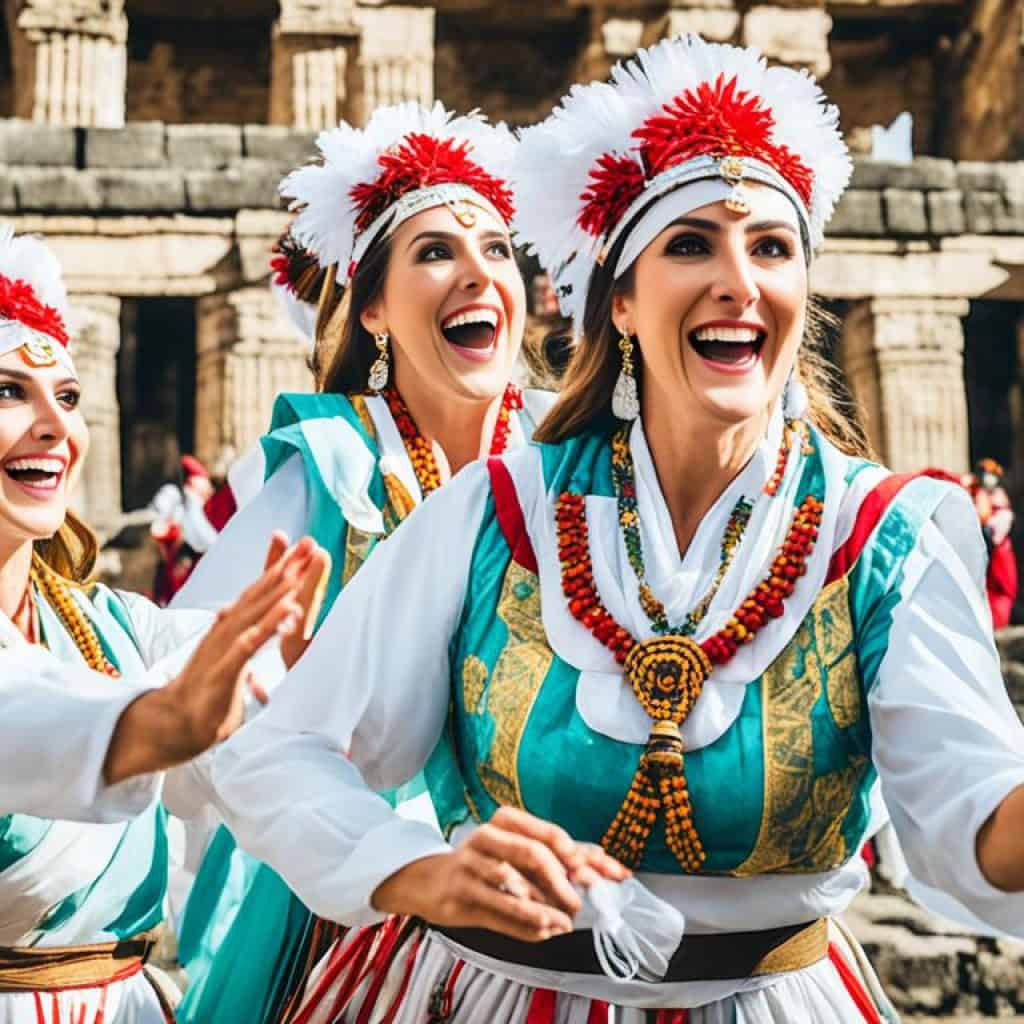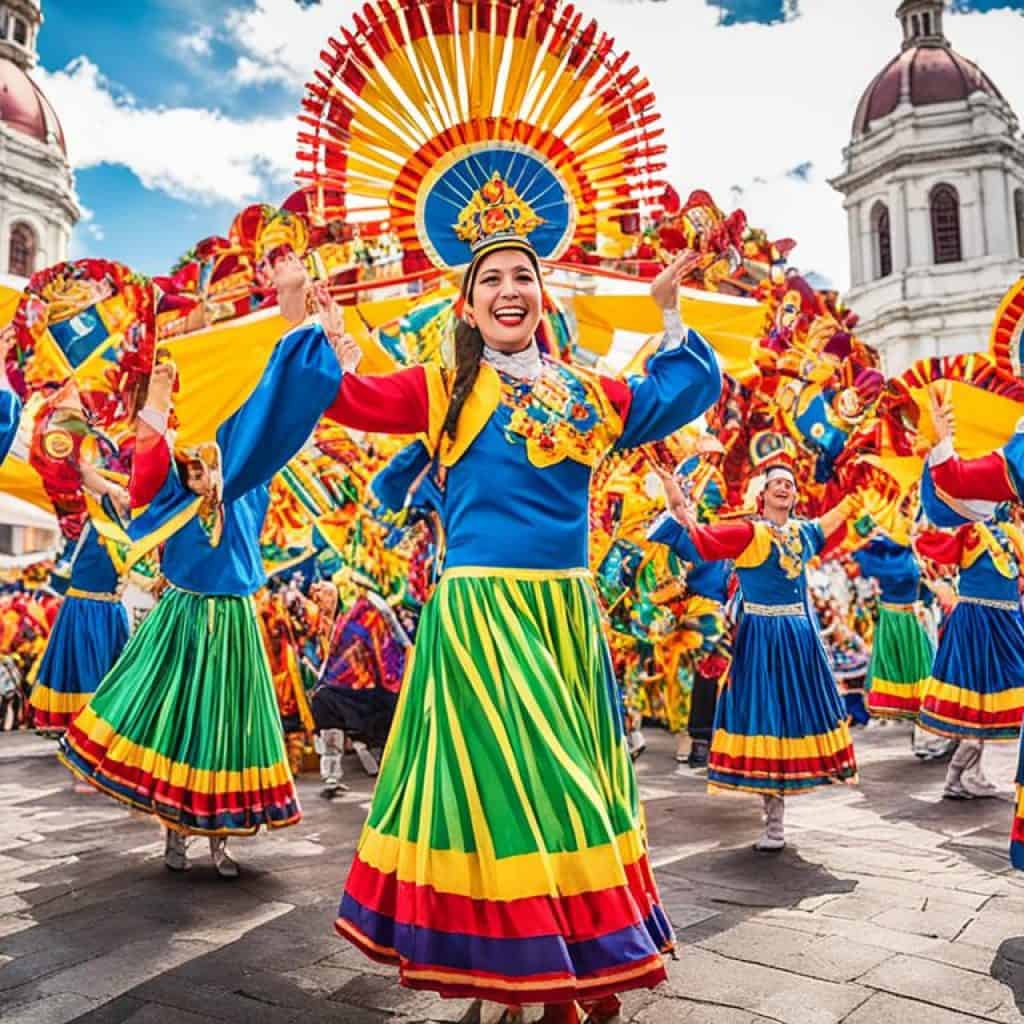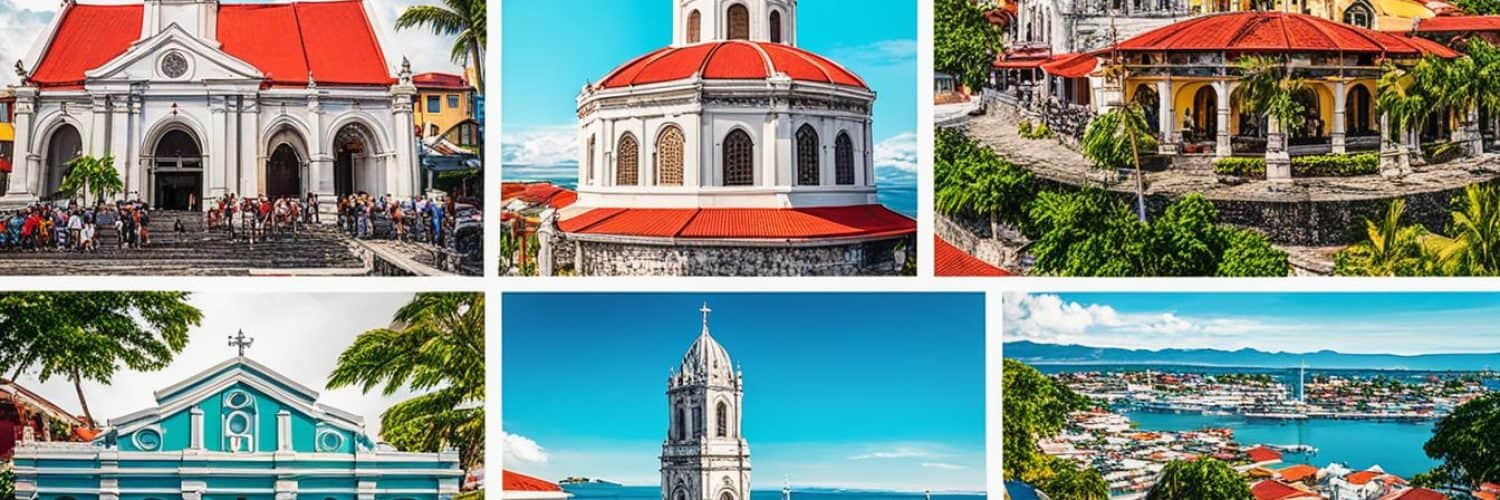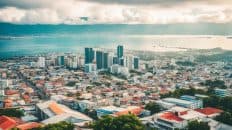Welcome to Cebu City, a place steeped in fascinating history and vibrant culture. Nestled in the central Visayan region of the Philippines, this city holds the title of being the country’s oldest settlement. But did you know that it was also once the Spanish colonial capital? Today, Cebu is a thriving metropolis, bustling with trade, education, and a deep sense of heritage.
Are you ready to uncover the captivating secrets of Cebu’s past and immerse yourself in its rich cultural tapestry? Join us on a quick guide through Cebu’s history and culture to discover the hidden gems that make this city truly remarkable.
Key Takeaways:
- Cebu City is the oldest settlement in the Philippines and was once the Spanish colonial capital.
- The city’s historical sites, cultural traditions, and diverse attractions make it a must-visit destination.
- Cebu’s heritage is preserved through landmarks, customs, festivals, and local cuisine.
- The city is a hub of education, trade, and commerce.
- Cebu’s natural beauty complements its historical and cultural attractions, providing a well-rounded experience.
The Oldest Settlement in the Philippines
Cebu City holds the distinction of being the oldest settlement in the Philippines. It was here that Ferdinand Magellan, the Portuguese explorer, landed in 1521 and sealed a blood compact with Humabon, the chief of Cebu. However, Magellan was later killed by Chief Lapulapu of Mactan Island. In 1565, Miguel López de Legazpi arrived in Cebu and founded the first Spanish settlement and Roman Catholic mission in the Philippine archipelago. Cebu remained the Spanish colonial capital for six years and played a crucial role in the country’s history as a key stronghold against foreign powers.
Preserving Spanish Heritage and Culture
Cebu City is a testament to the rich Spanish heritage and culture that has shaped its identity. From historical landmarks to vibrant traditions, Cebu embraces its colonial past as a source of pride and significance. The city pays homage to its Spanish influences through the preservation of iconic structures and the celebration of age-old customs.
One of the notable historical landmarks in Cebu City is Fort San Pedro. Built by the Spanish in the 16th century, this triangular bastion fort remains a testament to the city’s colonial history. It serves as a reminder of the fortitude and strategic importance of Cebu during the Spanish era. Visitors can explore its walls and imagine the stories that unfold within its ancient stones.
Another iconic site that showcases Cebu’s Spanish heritage is the Basilica del Santo Niño. As the oldest Roman Catholic church in the Philippines, it holds significant religious and cultural importance. The basilica houses the revered image of the Santo Niño, the Holy Child Jesus, which was brought by Ferdinand Magellan. Devotees and tourists alike gather here to pay their respects and seek blessings.
Magellan’s Cross, planted by the Portuguese explorer himself in 1521, marks a pivotal moment in Cebu’s history—the introduction of Christianity. Nestled in a small chapel near the Basilica del Santo Niño, it is a symbol of the city’s conversion to Catholicism. The cross stands as a powerful symbol of faith, unity, and history.
“Cebu City’s historical landmarks are not just architectural marvels; they represent our collective memory and provide a tangible link to our past.” – Mayor of Cebu City
Today, the customs and traditions of Cebu continue to reflect its unique blend of Spanish and local influences. The Cebuano people have preserved and passed down their rich heritage through generations. Deeply rooted in Catholicism and pre-colonial practices, these customs are celebrated through vibrant festivals, music, dance, and cuisine.
One of the most renowned festivals in Cebu City is the Sinulog Festival. Held every third Sunday of January, it pays homage to the Santo Niño and commemorates the Filipino people’s conversion to Christianity. The festival features street dances, colorful costumes, and religious processions, showcasing the Cebuano’s devotion to their faith and their history.
The preservation of Cebu’s cultural heritage is crucial in maintaining a sense of identity and pride among its people. It serves as a reminder of the resilience and strength that have shaped the city’s history. By honoring and promoting Cebuano traditions and customs, the city ensures that future generations will cherish and carry forward the legacy of their ancestors.
Preserving Cebu’s Cultural Heritage: Importance and Impact
Preserving Cebu’s cultural heritage is of paramount importance as it allows us to understand and appreciate the historical and cultural significance of the region. By maintaining landmarks, structures, and traditions, we not only preserve the legacy of our ancestors but also create a vibrant cultural tapestry that attracts visitors from around the world.
When visitors immerse themselves in the customs and traditions of Cebu, they gain a deeper appreciation for the city’s rich cultural heritage and develop a sense of connection to its history. This engagement fosters cultural understanding, promotes respect for diversity, and strengthens tourism, which contributes to the economic growth of the city.
By preserving and promoting Cebu’s cultural heritage, we safeguard our roots and ensure that future generations can experience and celebrate the beauty of our traditions.
| Fort San Pedro | Basilica del Santo Niño | Magellan’s Cross |
|---|---|---|
| Constructed by the Spanish in the 16th century | Oldest Roman Catholic church in the Philippines | Brought by Ferdinand Magellan in 1521 |
| Symbol of Cebu’s strategic importance | Home to the revered image of Santo Niño | Marked the city’s conversion to Christianity |
| Significant historical landmark | Cultural and religious pilgrimage site | Powerful symbol of faith and unity |
Thriving Trade and Commerce
Cebu City’s rich history is intertwined with its status as a center of trade and commerce. From its early days as a vital port for interisland commodities to its present role as a bustling metropolis, the city has consistently embraced its economic significance. Cebu City’s strategic location and excellent transportation infrastructure make it an ideal hub for both domestic and international businesses.
The city’s roots in trade can be traced back to its earliest days, where commodities such as copra, abaca, sugar, timber, and fish were exchanged. Today, Cebu City is known for its diverse range of industries that contribute to the local and national economy.
The textile industry in Cebu City is a thriving sector, producing a wide variety of garments and fabrics. From the production of fabrics to the creation of fashionable clothing, the textile industry plays a significant role in shaping Cebu City’s cultural heritage.
Cebu City is also renowned for its footwear industry, which produces quality shoes and sandals that are exported around the world. The craftsmanship and attention to detail in Cebu-made footwear have contributed to the city’s reputation as a global hub for shoemaking.
Another notable industry in Cebu City is the food processing sector, known for its high-quality processed food products. From dried mangoes to canned goods, the city’s food processing industry offers a taste of Cebu’s culinary traditions to a wider audience.
Furthermore, Cebu City boasts a thriving furniture industry, offering a wide range of exquisitely crafted furniture pieces that showcase the city’s cultural heritage. The furniture industry in Cebu City is known for its skilled artisans and their ability to blend traditional craftsmanship with modern design.
In addition to these industries, Cebu City is also a hub for the chemical industry, with companies engaged in the production and distribution of various chemical products. These products play a crucial role in various sectors, including manufacturing, agriculture, and healthcare.
Beyond its economic significance, Cebu City offers a plethora of cultural attractions that showcase the city’s heritage. From historical landmarks such as Fort San Pedro and Magellan’s Cross to vibrant festivals like Sinulog, visitors can immerse themselves in the rich cultural tapestry of Cebu City.
Step into the world of trade and commerce in Cebu City and discover the intersection of economic prowess and cultural heritage.
Education and Intellectual Pursuits
Cebu City is committed to the development of its people, placing a strong emphasis on education and intellectual pursuits. The city is home to several prestigious universities and academic institutions that have played a pivotal role in shaping the intellectual landscape of Cebu and the Philippines as a whole.
One of the notable universities in Cebu City is the University of San Carlos, which has a rich history dating back to 1595. It is recognized as one of the top universities in the country and offers a wide range of academic programs across various disciplines.
The Cebu Institute of Technology is another renowned institution, known for its focus on science, technology, engineering, and mathematics (STEM) education. The university prides itself on producing graduates who excel in their respective fields and contribute to societal development.
Southwestern University is a leading educational institution that offers programs in medicine, dentistry, nursing, and other health sciences. It is known for its state-of-the-art facilities and commitment to producing competent healthcare professionals.
The University of the Southern Philippines and the University of the Visayas are also esteemed institutions that provide quality education to students in Cebu City. These universities offer diverse academic programs, creating opportunities for intellectual growth and personal development.
By nurturing the next generation of thinkers, innovators, and leaders, these universities in Cebu City contribute significantly to the intellectual and cultural development of the region. Through education, Cebu City preserves its cultural practices and traditions, ensuring that they are passed on to future generations.

From left to right: University of San Carlos, Cebu Institute of Technology, Southwestern University, University of the Southern Philippines, University of the Visayas
Vibrant Festivals and Celebrations
Cebu City is renowned for its vibrant festivals and celebrations that showcase the city’s rich cultural heritage. These events serve as a testament to the deep-rooted traditions and customs that have been passed down through generations. Among the most notable festivals held in Cebu is the Sinulog Festival, which takes place every third Sunday of January. This grand celebration commemorates the Filipino people’s conversion to Christianity and pays tribute to the Santo Niño, the patron saint of Cebu.
The Sinulog Festival features a spectacular parade of colorfully dressed dancers, gracefully moving to the rhythm of traditional music. The streets come alive with energy and excitement as revelers join in the festivities. Religious processions also form a significant part of the event, as devotees march through the city streets, expressing their devotion and gratitude.
Aside from the Sinulog Festival, Cebu City also hosts other captivating events that highlight the city’s unique cultural identity. The Kadaugan sa Mactan Festival, for example, commemorates the historic Battle of Mactan, where Lapulapu, a native chieftain, successfully defended the island against Spanish forces. This festival showcases reenactments of the battle, cultural performances, and local delicacies, offering visitors a glimpse into Cebu’s rich history. Additionally, the Pasko sa Sugbo celebration during the Christmas season showcases the city’s vibrant Christmas traditions, featuring dazzling light displays and captivating performances.
“Cebu City’s festivals and celebrations are a testament to the city’s cultural pride and heritage. The vibrant colors, lively dances, and captivating performances immerse visitors in the rich tapestry of Cebuano culture, leaving them with unforgettable memories.”
Experience the Vibrant Tapestry of Cebuano Culture
As visitors immerse themselves in these vibrant celebrations, they gain a deeper understanding of the significance of Cebu City’s cultural heritage. These festivals not only showcase the traditional dances and music of the region but also emphasize the values and beliefs that have shaped the Cebuano identity. Through colorful parades, religious processions, and spirited performances, visitors can witness firsthand the pride and passion that Cebuanos hold for their culture.
Join the Festivities and Make Lasting Memories
Attending these festivals and celebrations provides an opportunity for visitors to engage with the local community and build connections. Whether joining the Sinulog Festival’s street dances or indulging in the mouthwatering delicacies of the Pasko sa Sugbo celebration, visitors are invited to partake in the joyous atmosphere and create lasting memories. It is through these communal experiences that the true essence of Cebu City’s cultural attractions and heritage comes to life.
| Festival | Date | Description |
|---|---|---|
| Sinulog Festival | Every third Sunday of January | A celebration of the conversion to Christianity and homage to the Santo Niño, featuring street dances, religious processions, and cultural performances. |
| Kadaugan sa Mactan Festival | April 27 | Commemorates the Battle of Mactan and showcases reenactments, cultural performances, and local delicacies. |
| Pasko sa Sugbo | December | A Christmas celebration showcasing vibrant light displays, festive performances, and traditional Cebuano Christmas traditions. |
Exploring Historical Landmarks
Cebu City offers a plethora of historical landmarks that provide insights into its past. From ancient forts to religious symbols, these sites allow visitors to immerse themselves in the rich history of the city.
One such landmark is Fort San Pedro, built by the Spanish in the 16th century. As the oldest triangular bastion fort in the country, it stands as a testament to Cebu’s colonial history. Exploring the walls and cannons of this fort offers a glimpse into the city’s defensive strategies during that time.
Another significant landmark is the Basilica del Santo Niño. As the oldest Roman Catholic church in the Philippines, it holds great cultural and religious significance. Inside, visitors can view the image of the Santo Niño, a relic that represents Cebu’s conversion to Christianity. The church’s intricate architecture and peaceful ambiance create a solemn experience for pilgrims and tourists alike.
“The historical landmarks in Cebu City connect us to our roots and remind us of the struggles and triumphs that shaped this vibrant city.” – Local Historian
A visit to Cebu City wouldn’t be complete without witnessing Magellan’s Cross. Planted by Ferdinand Magellan himself in 1521, this iconic cross symbolizes the birth of Christianity in the Philippines. Located in a small chapel, it serves as a symbol of faith and endurance, attracting visitors from all over the world who seek to pay their respects.
Exploring these historical landmarks allows visitors to step back in time and gain a deeper understanding of Cebu City’s storied past. From fortresses that withstood battles to religious symbols that shaped the city’s identity, each landmark offers a unique perspective on Cebu’s historical journey.
Immerse in Local Traditions and Customs
To truly experience the essence of Cebu City’s history and culture, one must immerse in its local traditions and customs. Cebuanos take pride in their heritage, showcasing it through various practices that have been passed down through generations.
The Sinulog Dance
One of the most prominent traditions in Cebu City is the Sinulog dance. This vibrant and energetic dance is performed during the annual Sinulog Festival, which celebrates the Filipino people’s conversion to Christianity. The Sinulog dance is characterized by rhythmic movements and colorful costumes, and it is a visual spectacle that captivates both locals and tourists.
Handcrafted Guitars and Ukuleles (“Sistas”)
Another unique tradition in Cebu City is the handcrafting of guitars and ukuleles, locally known as “sistas.” Cebu is renowned for producing high-quality musical instruments, and visitors have the opportunity to witness the skilled craftsmanship firsthand. The guitar-making industry in Cebu City dates back to the Spanish colonial period, and the tradition continues to thrive today.
Celebration of Fiestas
Fiestas play a significant role in Cebuano culture, with each barangay (community) having its own celebration. These vibrant festivals bring people together to honor patron saints and showcase unique customs and traditions. During fiestas, visitors can immerse themselves in the lively atmosphere, enjoy traditional music and dances, and savor delicious local delicacies.
“Embracing the customs of Cebu City allows for a deeper appreciation of its cultural tapestry.”
The warmth and hospitality of the locals contribute to the genuine Cebuano spirit that pervades these customs. Visitors are warmly welcomed and encouraged to participate in the festivities, creating memorable experiences and fostering a greater understanding of Cebu City’s rich cultural heritage.
Discovering Natural Beauty
Beyond its rich history, Cebu City is a treasure trove of natural beauty that perfectly complements its cultural attractions. The city is blessed with stunning landscapes, pristine beaches, and breathtaking waterfalls, offering visitors a chance to connect with the captivating splendor of nature while exploring the historical landmarks in Cebu. From the iconic Kawasan Falls in Badian to the white sand beaches of Bantayan Island, there is a diverse range of natural wonders to discover in Cebu City.
One of the must-visit natural attractions in Cebu City is the mesmerizing Kawasan Falls in Badian. This three-tiered waterfall boasts crystal-clear turquoise waters, surrounded by lush greenery, creating a picture-perfect setting for relaxation and rejuvenation. Visitors can take a refreshing dip in the cool waters, go bamboo rafting, or simply marvel at the striking beauty of the cascading falls.
If you’re seeking a tranquil beach experience, Bantayan Island is the place to be. With its pristine white sand beaches and crystal-clear waters, it offers a serene haven where you can unwind and soak up the sun. The island’s laid-back atmosphere and breathtaking sunsets make it a popular destination for both locals and tourists looking to escape the hustle and bustle of city life.
For those who love adventure and natural wonders, Osmeña Peak is a must-see attraction. Located in Dalaguete, it is the highest peak in Cebu, offering panoramic views of the surrounding countryside and neighboring islands. The trek to the peak is relatively easy, making it accessible for hikers of all levels. Standing at the summit and witnessing the breathtaking landscape is an unforgettable experience.
When exploring Cebu City’s natural beauty, don’t miss the chance to visit the picturesque Tumalog Falls in Oslob. This stunning cascading waterfall, also known as “Toslob Falls,” features a unique curtain-like formation, creating a dreamy atmosphere. Visitors can swim in the cool waters and bask in the tranquil surroundings.
In addition to these natural attractions, Cebu City is home to numerous other waterfalls, caves, and hidden gems waiting to be discovered. Whether you’re an adventure seeker, a nature lover, or simply craving a peaceful escape, Cebu City’s natural beauty offers something for everyone.
Immerse in the Serenity of [cebu cultural attractions]
As you explore the historical landmarks and cultural attractions in Cebu City, take a moment to immerse yourself in the serenity of its natural wonders. Whether you choose to unwind on the shores of Bantayan Island or embark on an exhilarating trek to Osmeña Peak, the natural beauty of Cebu City provides a refreshing contrast to the city’s vibrant culture and rich history. So, pack your bags and get ready to discover the breathtaking landscapes that make Cebu City a truly remarkable destination.
| Natural Attraction | Location |
|---|---|
| Kawasan Falls | Badian |
| Bantayan Island | Bantayan |
| Osmeña Peak | Dalaguete |
| Tumalog Falls | Oslob |
Indulging in Local Cuisine
No exploration of Cebu City’s history and culture is complete without indulging in its local cuisine. Cebu is renowned for its lechon, a roasted pig dish that is considered a Filipino culinary masterpiece. The city’s lechon is known for its crispy skin and flavorful meat, making it a must-try for food enthusiasts. The succulent lechon is often the centerpiece of festive occasions and celebrations, showcasing the pride and culinary expertise of the Cebuanos.
Cebu City is also known for its seafood delicacies, offering a delectable array of flavors from the bountiful waters surrounding the island. One of the most popular seafood dishes is sutukil, a combination of three different cooking methods: sugba (grilled), tinola (soupy), and kinilaw (ceviche). Sutukil allows visitors to experience the freshness and diversity of Cebu’s seafood, with dishes like grilled fish, seafood soup, and marinated raw fish served with vinegar and spices. These seafood specialties highlight the region’s coastal heritage and the abundance of seafood that defines Cebu’s cuisine.
Exploring Cebu’s food scene is a culinary adventure that introduces visitors to the intersection of various culinary traditions influenced by Chinese, Spanish, and indigenous flavors. The city offers a wide range of dining options, from humble eateries serving local street food to upscale restaurants offering contemporary interpretations of traditional dishes. Whether you’re savoring the tangy flavors of tinola or indulging in the tender and flavorful lechon, Cebu City’s culinary offerings provide a feast for the senses.
So, when you visit Cebu City, don’t miss the opportunity to immerse yourself in its vibrant food culture. Sample the iconic lechon and discover the wonders of sutukil, alongside other local delicacies like puso (hanging rice) and ngohiong (Cebuano spring rolls). By indulging in Cebu’s culinary treasures, you’ll not only satisfy your taste buds but also gain a deeper understanding of the cultural practices and traditions that have shaped the city’s gastronomic landscape.
Practical Information and Tips
Before embarking on a journey to explore Cebu City’s history and culture, it’s essential to know some practical information and tips. Here are some things to keep in mind to ensure a smooth and enjoyable experience:
- Local Currency: The currency used in Cebu City is the Philippine Peso (PHP). It’s advisable to exchange your currency to PHP before arriving or at one of the local currency exchange centers in the city.
- Language: English is widely spoken in Cebu City, making communication with locals easier for international visitors. However, learning a few basic Cebuano phrases can also be helpful and appreciated.
- Dress Code: When exploring Cebu City, it’s important to dress comfortably, especially during festival seasons or when visiting religious sites. Modest attire is generally appreciated when visiting churches or religious landmarks.
- Transportation: Getting around Cebu City is convenient and accessible. You can choose from various transportation options, including taxis, jeepneys (local public transportation vehicles), or app-based ride-hailing services like Grab. It’s advisable to have small bills for taxi rides, as some drivers may not carry a lot of change.
- Respecting Local Customs: As you explore the city, it’s important to respect local customs and traditions. Cebu City has a rich cultural heritage, and being mindful of local customs while interacting with the locals will make your experience more enjoyable and meaningful.
“Cebu City is a vibrant destination with a diverse cultural heritage. By being aware of the practical information and tips, visitors can ensure a seamless and respectful exploration of the city’s history and culture.”

Exploring Cebu City’s history and culture is an enriching experience that allows visitors to immerse themselves in the vibrant tapestry of Cebuano traditions and customs. By keeping these practical tips in mind, you can make the most of your journey and create lasting memories in this historically and culturally significant destination.
Sample Itinerary in Cebu
To make the most of your visit to Cebu City and explore its historical landmarks and cultural heritage, here’s a sample itinerary that will guide you through the highlights of this enchanting destination:
Day 1: Uncovering Cebu’s Rich History
- Start your day with a visit to Fort San Pedro, the oldest triangular bastion fort in the Philippines. Explore its historic walls and immerse yourself in Cebu’s colonial past.
- Next, head to Magellan’s Cross, a significant historical landmark that symbolizes the city’s conversion to Christianity. Take a moment to soak in the cultural and religious significance of this iconic site.
- Make your way to the Basilica del Santo Niño, the oldest Roman Catholic church in the country. Admire the stunning architecture and pay respects to the Santo Niño, the patron saint of Cebu.
- Wrap up your day by exploring the vibrant streets of Colon Street, the oldest street in the Philippines. Immerse yourself in the local culture, bustling markets, and charming shops.
Day 2: Cultural Immersion and Scenic Delights
- Embark on a day trip to the nearby island of Mactan. Visit the Lapu-Lapu Shrine, erected in honor of Lapu-Lapu, the native chieftain who defeated Ferdinand Magellan in the Battle of Mactan.
- Experience the vibrant Sinulog Festival at Cebu City’s streets, held every January, where locals and tourists alike come together to celebrate the city’s rich cultural heritage through colorful parades and traditional dances.
- Take a refreshing dip at Kawasan Falls in Badian, known for its crystal-clear turquoise waters and dramatic cascades. Enjoy a picnic lunch amidst the lush surroundings.
- End your day by witnessing the breathtaking sunset at Top of Cebu, a popular viewpoint that offers panoramic views of the city and the surrounding islands.
Day 3: Nature and Culinary Delights
- Embark on a day trip to Oslob and swim with the majestic whale sharks. Get up close and personal with these gentle giants and create unforgettable memories.
- Indulge in a sumptuous seafood feast at Larsian or one of the many local eateries offering mouthwatering Cebuano delicacies. Don’t forget to sample the famous Cebu lechon for a truly authentic culinary experience.
- Visit the Taoist Temple nestled in the hills of Beverly Hills. Explore its intricate architecture and take a moment for reflection in this serene and spiritual space.
- Round off your evening with a leisurely stroll along Cebu’s waterfront, enjoying the cool ocean breeze and taking in the city’s vibrant nightlife.
With this itinerary, you’ll be able to immerse yourself in Cebu City’s historical landmarks, experience its vibrant culture, and witness the natural beauty that surrounds this captivating destination.
Discover the Unique Attractions in Cebu
Exploring History and Culture
Cebu City is a treasure trove of unique attractions that showcase its fascinating history and vibrant culture. From exploring historical landmarks that pique your curiosity to immersing yourself in local customs and traditions, there is something for every traveler in Cebu. Let’s dive into the remarkable attractions that will make your visit to Cebu City truly unforgettable.
Historical Landmarks: Reliving the Past
Cebu City is home to several historical landmarks that transport you back in time. Visit Fort San Pedro, the oldest triangular bastion fort in the Philippines, and uncover its rich colonial history. Marvel at Magellan’s Cross, a symbol of Cebu City’s conversion to Christianity and a testament to the city’s enduring spirit. These landmarks offer glimpses into the past that will leave you in awe of Cebu’s historical significance.
Immerse in Local Customs and Traditions
To truly experience the vibrant culture of Cebu, immerse yourself in its local customs and traditions. Witness the Sinulog dance, a colorful spectacle that celebrates both history and faith. Engage with the locals and learn about their time-honored practices, such as the art of handcrafting traditional guitars and ukuleles known as “sistas”. Embracing Cebu’s cultural practices allows you to connect with the heart and soul of the city.
Natural Beauty: A Haven for Nature Lovers
Cebu City is not only rich in history and culture but also blessed with breathtaking natural beauty. Explore its pristine beaches, dive into its crystal-clear waters, or hike through lush mountains to discover its natural wonders. From the majestic Kawasan Falls to the idyllic beaches of Bantayan Island, Cebu’s natural attractions offer a serene escape from the hustle and bustle of the city.
Indulge in Local Cuisine: A Gastronomic Delight
No visit to Cebu City is complete without indulging in its mouthwatering local cuisine. Savor the world-famous lechon, a succulent roasted pig dish that showcases the city’s culinary prowess. Delight your taste buds with fresh seafood delicacies, such as the popular sutukil, which combines grilled, stewed, and raw seafood in a delightful gastronomic experience. Cebu’s culinary offerings are a true reflection of its cultural heritage.
Participate in Vibrant Festivals
Be part of Cebu’s vibrant festivals and celebrations, which bring the city to life in a burst of colors and music. Join the Sinulog Festival, a grand celebration of faith and culture that attracts both locals and tourists. Experience the Kadaugan sa Mactan, which commemorates Lapu-Lapu’s victory over Magellan, or celebrate the Pasko sa Sugbo to embrace the joy of Christmas in Cebu. These festivals showcase the city’s lively spirit and deep-rooted traditions.
Whether you’re a history enthusiast, a culture lover, or a nature explorer, Cebu City offers a plethora of unique attractions that cater to all interests. Plan your visit now and embark on a journey to discover the wonders of Cebu’s history, culture, and natural beauty.
Conclusion
Exploring Cebu City’s history and culture is a journey that takes you deep into the captivating past and vibrant present of this remarkable destination. As the oldest settlement in the Philippines, Cebu City holds a unique place in history and serves as a testament to the fusion of influences that have shaped its cultural heritage.
From its role as the Spanish colonial capital to its thriving trade and commerce, Cebu City offers a wealth of experiences for visitors to connect with its rich history. The city’s historical landmarks, such as Fort San Pedro and Magellan’s Cross, provide glimpses into its colonial past, while local traditions and customs bring the vibrant culture to life.
But Cebu City is not just about history and culture – its natural beauty adds another layer of fascination. Pristine beaches, breathtaking waterfalls, and stunning landscapes provide a refreshing contrast to the historical landmarks, allowing visitors to appreciate the diverse tapestry that Cebu City offers.
Whether you’re a history enthusiast, a culture lover, or a nature explorer, Cebu City has something to captivate your senses. The richness of its history and the vibrancy of its culture make Cebu City a truly remarkable destination that will leave you with lasting memories of its captivating heritage.


















Add comment